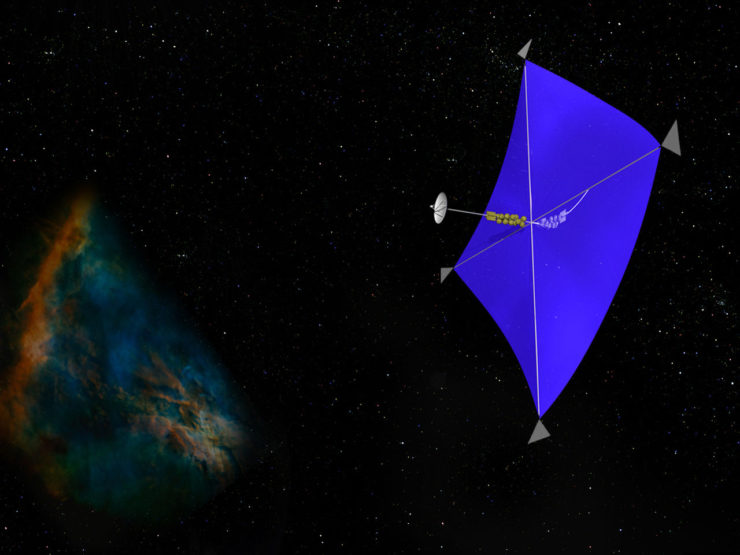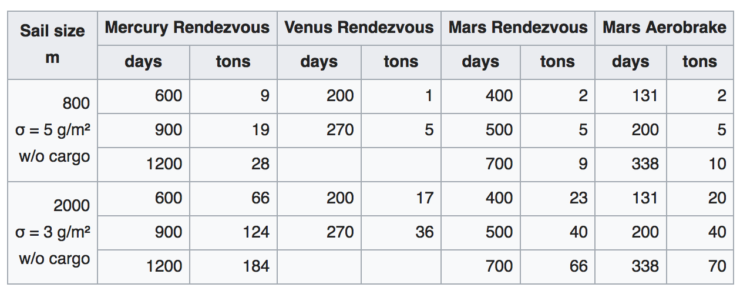The classical rocket equation—M/m = e^(delta-v/exhaust velocity)—is a harsh mistress. If you want increased velocity, you have to increase fuel. For every increase in delta-v, you increase the ratio between the dry mass of a spacecraft and the fully fuelled mass. The ship gets heavier, needs more fuel, yadda yadda.
This is a pain for the sort of SF author who aims at a patina of verisimilitude: chemical rockets, for example, are limited to comparatively small delta-vs (which is why, for example, so few probes have been sent to Mercury). There are a number of ways to sidestep the limitations imposed by the rocket equation, the most straight forward of which is to somehow obtain the necessary thrust from some external source…which brings us to light sails.
Light bouncing off a mirrored surface does not exert much force. A light sail one square kilometre in area, located at 1 AU, would experience about 8 newtons of force from the sunlight bouncing off it. 8 newtons is about the force two blocks of butter would exert on your hand as you held them up against gravity. Still, small forces for very long times can provide surprisingly large delta-vs. This eight newtons/kilometre squared is free and available for as long as the sun shines. Wikipedia is kind enough to provide some idea of the potential this offers:
You might think that taking almost two years to park nine tons in Mercury orbit is slow…but remember that it took conventional rockets (and flybys) seven years to get MESSENGER’s single ton to Mercury.
Rather surprisingly, while it should have been intuitively obvious after the mid-19th century that light exerts pressure, it took about another century for science fiction authors to pick up on this fact. Indeed, even though the first popular science piece on light sails of which I am aware, Russell Saunders’ “Clipper Ships of Space,” appeared in 1951, the first SF short stories and novellas featuring light sails of which I am aware (Cordwainer Smith’s “The Lady Who Sailed the Soul,” Jack Vance’s “Gateway to Strangeness” aka “Sail 25,” Poul Anderson’s “Sunjammer,” and Arthur C. Clarke’s “Sunjammer,” later renamed “The Wind From the Sun”) did not appear until 1960, 1962, 1964, and 1965, respectively.
Possibly the reason that light sails took a while to become popular tropes is that the scientifically-clued-in authors who would have been aware of the light sail possibility would also have known just how minuscule light sail accelerations would be. They might also have realized that it would be computationally challenging to predict light sail trajectories and arrival times. One-g-forever rockets may be implausible, but at least working how long it takes them to get from Planet A to Planet B is straightforward. Doing the same for a vehicle dependent on small variable forces over a long, long time would be challenging.
Still, sailing ships in space are fun, so it’s not surprising that some authors have featured them in their fiction. Here are some of my favourites:
Light sails feature prominently in the late Vonda N. McIntyre’s Starfarers quartet. However, since I already mentioned those books in an earlier essay (and don’t like featuring the same books over and over) consider 1974’s “The Mountains of Sunset, the Mountains of Dawn.” One of two stories about a race of birdlike aliens, this explores a period in their history when their species has set out in light sail-propelled sublight ships. Their voyage is by its nature slow and by the time they reach their first destination, the newest generation has grown accustomed to living in their artificial world. Nevertheless, one elder is determined to descend to a world in which its fellows have little interest.
Joan D. Vinge’s 1978 Hugo-nominated “View from a Height” was inspired by a Robert Forward proposal regarding one-way interstellar missions. In the real world we sidestep the issues involved by dispatching expendable robots on one-way journeys. Vinge wondered what would motivate someone to volunteer for a one-way crewed mission into deep space, and this novella resulted.
The spacecraft in Yūichi Sasamoto’s Bodacious Space Pirates light-novel series are, for the most part, fairly conventional rockets (with a side order of faster than light travel to circumvent the whole “dying of old age while waiting to reach one’s destination” thing). Plucky schoolgirl-turned-privateer Marika Kato and her crew of equally plucky schoolgirl space-yacht-club members set out on the Odette II, a light sail craft with a dubious history. They thought that history was safely buried, never to return; this being an adventure series, they are proved wrong.
The Congregation of Alastair Reynold’s 2016 Revenger is merely the latest of a long line of civilizations that have occupied the myriad worlds orbiting the Old Sun. Eager to plunder the treasures left by their predecessors, travelers ply the space lanes in ships propelled by high-tech light sails. Of course, some very bad people have figured out the obvious: that it is easier to let other people do the searching, then simply commandeer their hard-earned treasure. The Ness sisters hoped to find freedom and fortune in space. What they find instead is considerably darker.
If, however, fictional light sails are not enough for you, I have good news. The same strengths that appeal to writers also appeal to people eager to explore our solar system. Although space exploration bureaucracies are by their nature technologically conservative (preferring conventional but reliable methods to the cool but untested) there have been some trials of light sail craft. There have, of course, been setbacks—Sunjammer was cancelled in 2014—but there have also been successes: JAXA’S light sail IKAROS successfully made its way past Venus in 2010. In June, The Planetary Society’s LightSail 2’s launch window opens. I hope it is as successful as IKAROS.
In the words of Wikipedia editor TexasAndroid, prolific book reviewer and perennial Darwin Award nominee James Davis Nicoll is of “questionable notability.” His work has appeared in Publishers Weekly and Romantic Times as well as on his own websites, James Nicoll Reviews and Young People Read Old SFF (where he is assisted by editor Karen Lofstrom and web person Adrienne L. Travis). He is a finalist for the 2019 Best Fan Writer Hugo Award, and is surprisingly flammable.











